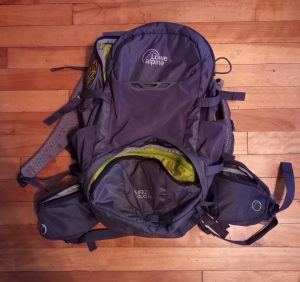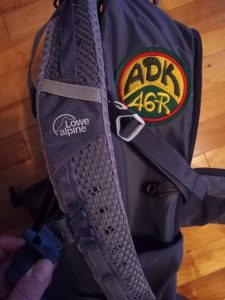

In my hiking day-pack
- Hiking poles (attached to the outside)
- Bag containing water purification system
- First aid/emergency supplies kit
- Toilet paper
- Camelback bladder (empty)
- Compass
- Pocket knife
- Towel
- Duck tape
- Ziplock back with garbage
- Lip balm
- Empty milk bag
- Head band
- Hair elastics
- Bobby pins
- Headlamp and batteries
- Mask
- Sun hat
- Raincoat
- Lightweight fleece sweater
Items normally in my pack that are missing in this moment
- Nalgene bottle
- Food
- Map
Before diving into what can be gleamed from the content of my bag (and from my bag itself), I would like to highlight a couple significant pieces of information provided by Scholes (1992). Scholes (1992) wrote that “a text is a cluster of signs or potentially signifying entities that can be connected by an act of reading to other such clusters” (p. 155). My bag, its components, and its contents are a cluster of signs; they provide clues that when connected together and to a larger context, provide insight to who I am as a person if only you know how to read them. This brings me to a second important point.
Scholes (1992) wrote, “we can make sense of things only by establishing our own connections within the network of textuality that enables our thinking and perceiving in the first place” (p.153). Thus, if you don’t have any prior knowledge or understanding of hiking, you might not be able to gain as much understanding from my bag as from someone who is well versed in hiking.
My bag and its contents quickly indicate that I spend some time outdoors, where there is limited access to amenities such as places with toilet paper. The inclusion of the hiking poles hints more specifically to hiking.
This bag tells the story of having returned from a hike: there is no food, the garbage bag has garbage in it, the water containers are empty or missing, and the map is missing as it was also used for road navigation. The normal tidying of my bag was only half-completed; while leftover food was removed, normally after a hike, the camelback would be stored in the freezer and the garbage would be emptied.
The mask in my bag provides a piece of temporal information. Only since the spring of 2020, did masks become a normal item for me to carry.
Many of the items in my day pack are there in case the “what if” happens. First aid kit… what if someone is injured? Water purification system… what if I run out of water? Headlamp and extra batteries… what if I don’t make it back before dark AND what if my first set of batteries die? Compass… what if I get lost? Pocket knife… what if I need to cut something? Towel… what if I want to dry my feet after a spontaneous dip in a creak that may or may not exist? Raincoat… what if it rains? Fleece sweater… what if I get cold? Duck tape… what if I need to make a repair? I think much of this comes from growing up in Girl Guides where our motto was “Be prepared.” Really, the items that I use the most consistently when hiking are those that are missing: the food, my Nalgene and the water that would fill it and the Camelback bladder, and the map.
When considering the items in my pack, the ones that stand out as being the most textual, are the map and compass. We say things like “read a map” or “read a compass.” The map (even though it is technically not present) and compass represent a literacy specific to a subset of the population; few people have the need and/or ability to read a map and compass. Having the compass in my pack indicates that I theoretically have the ability to read a map and compass in order to find my way. I say theoretically, because it is not unheard of for people to carry a compass and map despite being incapable of using them and if I am being completely honest, I probably overestimate my own ability to skillfully use them.
On the strap of my bag is a whistle (seen in the bottom left of the photo below), which serves as as communication tool in case of emergency. On it’s own, the whistle does not provide much information but when needed it can be used to convey information. In my experience as a Girl Guide, I learnt that 3 short blasts communicates that the user requires assistance.
Thinking more about the map and compass, it is interesting to think about the various types of texts that I am able or unable to read. While I am comfortable with a map/compass, crochet patterns, and recipes, I am limited in my ability to read other texts like sheets of music. What I am (un)able to interpret is part of my identity and describes elements that have significance in my life. Reflecting further on this concept of identity, my bag and its contents provide a lot of information about my identity to a hypothetical archaeologist.
Personally, the badge sewn into the side of the bag serves to identify myself as a member of a select group of hikers. I wear it on my pack as a symbol to other 46ers that I am one of them. For an outsider, a quick search of the internet explains that the badge represents the feat of having climbed the 46 high peaks of the Adirondacks in New York.

Many of the items point towards my gender identity although nothing definitively identifies me as one gender or the other. To guess at my gender, one must use stereotypical assumptions. Many of the items are pink or purple which are typically colours associated with females. The hair elastics indicate I have long hair, again another trait more often (but not exclusively) associated with females. The pack is a women’s pack although nothing obviously indicates it as such; only by searching the name of the pack (Lowe Alpine Airzone Z Duo 25) or understanding the design differences between women’s and men’s packs would someone know that it is a women’s pack. It could simply be that I am a small-framed man with long hair who prefers the colors of pink and purple.
The Ziplock dedicated to garbage is identified as such because I will most often reuse the same bag by simply emptying the contents into a larger bag or container at home. Being environmentally conscious, I do not wish to waste multiple plastic bags, but I do not want to confuse an empty garbage bag with a food-safe bag.
By examining my bag and the objects within, one can read it as a type of biography. By making judgements and connections to other texts, the reader can guess at my gender, preferences, and values. By looking at details like the size of my clothing, the reader can also guess my physical size. The straps of my pack might also provide insight to my size. Examination of the empty milk bag, carried for unexplained purposes, identifies me as likely being from Quebec and being someone who consumes dairy.
References
Scholes, R. (1992). Canonicity and textuality. In J. Gibaldi (Ed.), Introduction to scholarship in modern languages and literatures (2nd ed.), (pp. 138-158). Modern Languages Association of America. https://pages.mtu.edu/~rlstrick/rsvtxt/scholes.pdf